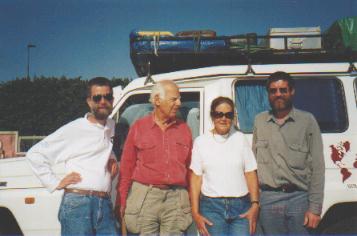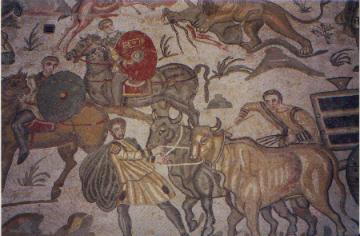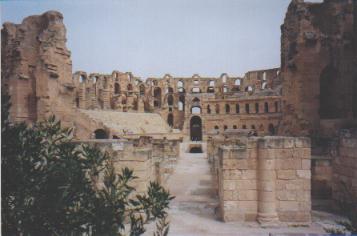Newsletter #15
15-March-2000
Europe/Tunisia
Hello friends,
After finishing our African trip, the lure of Africa was too great.
We enjoyed the Sahara Desert in Sudan so much that we decided to spend
two months in Northern Africa visiting Tunisia, Libya and possibly southern
Algeria. Kienny decided that she would stay home and look after Su-Lin,
so I'm travelling with John Sandefur and Max and Sheila Newman. John is
an old friend from the Territory (though he's been living in Melbourne
for the past 10 years -- ugh!). Max and Sheila are friends from Sydney
who travelled through Africa a few years ago.
When Kienny, Su-Lin and I finished our African trip, we left Troopy
in the UK. Max and Sheila flew over a fortnight ago and picked up Troopy.
It was a great relief and pleasure when John and I landed in Milan, Italy
two days ago to find Max and Sheila waiting for us with Troopy.
 For
the last couple of days while we've been recovering from jetlag, we've
driven along the Italian and French Riviera from Genoa to Nice. It's been
a very pretty drive, with the mountains coming down to meet the lapping
waves of the Mediterranean Sea, with villages and towns clinging to the
mountains sides and along the narrow strip of land by what they call beaches...
not to be compared with our Australian beaches! We especially enjoyed driving
through Monte Carlo, with a diversion through one of the suburbs of the
rich and famous!
For
the last couple of days while we've been recovering from jetlag, we've
driven along the Italian and French Riviera from Genoa to Nice. It's been
a very pretty drive, with the mountains coming down to meet the lapping
waves of the Mediterranean Sea, with villages and towns clinging to the
mountains sides and along the narrow strip of land by what they call beaches...
not to be compared with our Australian beaches! We especially enjoyed driving
through Monte Carlo, with a diversion through one of the suburbs of the
rich and famous!
We had pleasant weather. It was a little cool, but no rain while
travelling through the Italian and French Riviera on the way to Marseilles.
As we could not find anywhere to camp in Marseilles, we headed down the
coast to Cassis where we found a good campsite by the ocean. The following
day we drove back to Marseilles and took the overnight ferry to Tunisia.
The ferry we took was the Carthage, a new Tunisian ferry that goes between
France, Italy and Tunisia. This was not a little boat. It carried 2260
passengers and 666 cars! It was totally staffed by Tunisians. The four
of us shared a very comfortable cabin for the twenty two hour journey across
the Mediterranean. We had three meals while on board, each in a different
restaurant. The ship had a swimming pool and a spa, but we couldn't use
it as the weather was not warm enough. We spent three hours trying to process
our visa application only to find that for Australians this had to be done
in port. On arrival in Tunis the next day, immigration and customs took
a couple of hours although the procedures were relatively straightforward.
It was a delight to drive out of the port and fill up the fuel tanks at
African prices instead of exorbitant European prices.
 We
spent three days in Tunis. Our first task was to go to the Libyan consulate
to get our visa to enter Libya. The invite provided to us by Azar Tours
was waiting for us at the Libyan consulate. This made the formalities of
getting the visa go very smoothly and our visa was processed overnight.
While in Tunis, Max and Sheila stayed at the Amilcar Hotel in Sidi Bou
Said while we camped on a vacant block of land by the beach next to the
hotel. Not only did we use Max and Sheila's shower, but they also lined
their pockets each morning with eggs and toast from the restaurant for
us!
We
spent three days in Tunis. Our first task was to go to the Libyan consulate
to get our visa to enter Libya. The invite provided to us by Azar Tours
was waiting for us at the Libyan consulate. This made the formalities of
getting the visa go very smoothly and our visa was processed overnight.
While in Tunis, Max and Sheila stayed at the Amilcar Hotel in Sidi Bou
Said while we camped on a vacant block of land by the beach next to the
hotel. Not only did we use Max and Sheila's shower, but they also lined
their pockets each morning with eggs and toast from the restaurant for
us!
Sidi Bou Said is close to Carthage. We drove through Carthage and had
a glance at some the few remaining ruins, which was not very much at all.
Incidentally, the Amilcar Hotel is named after the father of Hannabul,
the Phoenician from Carthage who took his hundreds of elephants over the
Alps in his attempt to defeat the Romans in Italy.
On Sunday we visited the museum at Le Bardo which is reputed to contain
"the finest collection of Roman mosaics in the world", a claim that we
feel is justified. The museum is housed in the Bardo Palace that was built
in 1249 and has been a museum since 1888. From there we drove north to
the coastal town of Bizerte. We visited Bizerte because John's father went
ashore here during WWII while his ship was offloading supplies for the
US Army. This is the largest town in the north of Tunisia and is not on
the general tourist route, although it is a popular holiday area for Tunisians.
We had a very pleasant stroll around town and enjoyed a cup of coffee on
top of the wall of the Kasbah, the old town fort built by the Ottomans
in the 17th century. (Bizerte was founded in the 8th century BC by the
Phoenicians.)
 On
Monday we strolled through the souq or market of the Medina or old town
area of the city with it's narrow cobblestone streets with covered archways
and tiny recessed shops selling all sorts of everyday items to handicrafts
for the tourists.
On
Monday we strolled through the souq or market of the Medina or old town
area of the city with it's narrow cobblestone streets with covered archways
and tiny recessed shops selling all sorts of everyday items to handicrafts
for the tourists.
On Tuesday we headed southeast towards Libya. The roads that we travelled
on through Tunisia were very good. Much of the countryside was covered
in Olive trees. Around Tunis the soil was very fertile with good rains,
but the further south we went, it got drier and drier. As we approached
the town of El Jem between Sousse and Sfax, rising before us in the middle
of the road was a Roman Colosseum that is almost as big as the one in Rome!
Built in 230AD, the Colosseum could hold 30,000 spectators. The ancient
town of El Jem was the source of many of the mosaics housed in the Le Bardo
museum in Tunis. Water for the ancient town was supplied through a 15 Km
underground aqueduct. We camped the night in a camping ground amongst a
stand of date palms in the town of Gabes.
Tomorrow we head to into Libya.
Best Wishes from Tunisia,
Geoff Kingsmill and John Sandefur
UPDATE MAY-2000
Taking the Ferry from Europe
to Tunisia.
There are three main routes from Europe to Tunisia.
France (Marseille) and Tunis.
There is at least one weekly ferry
service operated by SNCM (French Shipping Line) and/or CTN (Tunisian Shipping
Line)
Italy (Genoa/Genova) and Tunis
There is at least one weekly
ferry service operated by SNCM (French Shipping Line) and/or CTN (Tunisian
Shipping Line)
Italy-Sicily (Palermo) and Tunis.
There is at least one weekly ferry
service operated by Tirrenia (Italian
Shipping Line)
MotoEuropa
has a good WEB page which covers most Mediterranean Ferries.
In Tunis the CTN office, which is not far from
the main Tourist Office in the centre of town, handles all three shipping
lines.
In France SNCM
also handles CTN and Tirrenia bookings.
In the UK Southern
Ferries handles SNCM and CTN bookings.
A Carnet-du-Passage is not required for Tunisia.
European insurance companies can generally extent green card insurance
to cover Tunisia. On arrival in Tunisia we were asked to show our Green
Card Insurance.
Books
Chris Scott's "Sahara Overland - A route and planning
guide" book is recommended. If you look closely you'll even see a few pictures
of Troopy. His Sahara Travel
Information WEB page contains all the latest information for
overland travellers.



 For
the last couple of days while we've been recovering from jetlag, we've
driven along the Italian and French Riviera from Genoa to Nice. It's been
a very pretty drive, with the mountains coming down to meet the lapping
waves of the Mediterranean Sea, with villages and towns clinging to the
mountains sides and along the narrow strip of land by what they call beaches...
not to be compared with our Australian beaches! We especially enjoyed driving
through Monte Carlo, with a diversion through one of the suburbs of the
rich and famous!
For
the last couple of days while we've been recovering from jetlag, we've
driven along the Italian and French Riviera from Genoa to Nice. It's been
a very pretty drive, with the mountains coming down to meet the lapping
waves of the Mediterranean Sea, with villages and towns clinging to the
mountains sides and along the narrow strip of land by what they call beaches...
not to be compared with our Australian beaches! We especially enjoyed driving
through Monte Carlo, with a diversion through one of the suburbs of the
rich and famous!
 We
spent three days in Tunis. Our first task was to go to the Libyan consulate
to get our visa to enter Libya. The invite provided to us by Azar Tours
was waiting for us at the Libyan consulate. This made the formalities of
getting the visa go very smoothly and our visa was processed overnight.
While in Tunis, Max and Sheila stayed at the Amilcar Hotel in Sidi Bou
Said while we camped on a vacant block of land by the beach next to the
hotel. Not only did we use Max and Sheila's shower, but they also lined
their pockets each morning with eggs and toast from the restaurant for
us!
We
spent three days in Tunis. Our first task was to go to the Libyan consulate
to get our visa to enter Libya. The invite provided to us by Azar Tours
was waiting for us at the Libyan consulate. This made the formalities of
getting the visa go very smoothly and our visa was processed overnight.
While in Tunis, Max and Sheila stayed at the Amilcar Hotel in Sidi Bou
Said while we camped on a vacant block of land by the beach next to the
hotel. Not only did we use Max and Sheila's shower, but they also lined
their pockets each morning with eggs and toast from the restaurant for
us!
 On
Monday we strolled through the souq or market of the Medina or old town
area of the city with it's narrow cobblestone streets with covered archways
and tiny recessed shops selling all sorts of everyday items to handicrafts
for the tourists.
On
Monday we strolled through the souq or market of the Medina or old town
area of the city with it's narrow cobblestone streets with covered archways
and tiny recessed shops selling all sorts of everyday items to handicrafts
for the tourists.